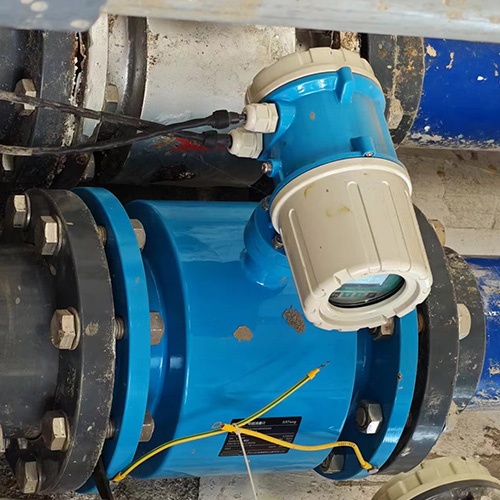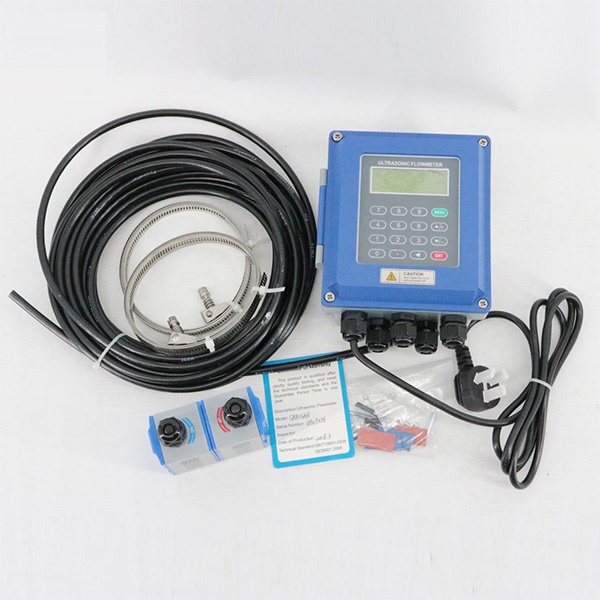-
Date:2025-08-21
-
Page View:195
The most common type of sludge flow meter is the electromagnetic flow meter, which operates based on Faraday’s law of electromagnetic induction. When conductive sludge flows through the magnetic flow meter, an electromotive force is generated. This force is proportional to the velocity of the sludge. The magnetic flow meter detects this electromotive force and converts it into a digital signal, which is used to calculate the flow rate of the sludge.
Types of Sludge Flow Meters
The selection of a sludge flow meter should take into account the characteristics of the sludge being measured—such as concentration, viscosity, and corrosiveness—as well as the material and dimensions of the pipeline. Below are some suitable types of flow meters:
1. Electromagnetic Flow Meters: Suitable for fluids with good electrical conductivity, such as wastewater and corrosive fluids. They are highly adaptable to sludge, which contains solid particles and conductive ions. Electromagnetic flow meters offer a wide measurement range, high accuracy, and strong corrosion resistance, making them ideal for measuring sludge flow containing solid particles.
2. Ultrasonic Flow Meters: Suitable for measuring high-viscosity fluids like sludge. They offer advantages such as non-contact measurement, easy installation, and a wide range of applications, making them particularly well-suited for fluids containing solid particles, corrosive substances, or high viscosity. In sludge treatment applications, ultrasonic flow meters can be used to measure flow in sludge pumping pipelines. However, care should be taken to avoid installation near pipe bends, areas with uneven flow distribution, or where air bubbles may be present.
3. Turbine Flow Meters: Suitable for various types of fluids, including those with high viscosity. They provide high accuracy, fast response times, and long service life. However, turbine flow meters are sensitive to pipeline vibration and perform poorly in the presence of impurities or air bubbles in the fluid.
4. Mass Flow Meters: Suitable for measuring various fluids, including those with solid particles, liquids, and gases. They provide high accuracy, are easy to install, and require simple maintenance. However, mass flow meters are relatively expensive compared to other types.
Proper maintenance of sludge flow meters is critical to ensuring their optimal performance and service life. Regular cleaning and calibration of flow meters is necessary to prevent any buildup or measurement errors. In addition, it is essential to monitor flow meters for any signs of wear and tear and replace any damaged parts in a timely manner. By selecting the right sludge flow meter and using it correctly, wastewater treatment plants can improve operations, reduce costs, and improve water quality.

Flow Meters for Slurry Applications

Non-Intrusive Ultrasonic Flow Meters
Which flowmeter is suitable for sludge flow measurement?
For the selection of sludge flow meters, various flow meters have their own advantages and disadvantages. In the process of sludge treatment, selection should be made according to actual needs.
The electromagnetic flowmeter is stable in measurement, has a wide range of applications, and can measure a variety of media. But it is easily interfered by electromagnetic waves. As the pipe diameter increases, its price will become more and more expensive.
Ultrasonic flow meters have relatively low cost and high measurement accuracy. run smoothly. Installation and maintenance are convenient, and the price will not increase with the increase of pipe diameter. But it will become more and more expensive because of the increase in sound channels.
The open channel flowmeter has a wide measurement range, and the flow measurement is not affected by changes in the medium. , But it is restricted by the size of the measuring tank. Generally speaking, when the installation conditions of open channels are met, the traffic data is large. Sewage flow operations can be transported through open channels. Weir flow meters and trough flow meters are used for related operations.
Advantages of electromagnetic flowmeter in sludge measurement
1. The electromagnetic flowmeter has no mechanical inertia. Responsive. Can measure instantaneous pulsating flow. It can also measure the flow in both directions.
2. The electromagnetic flowmeter has a very wide range. The measurement range can reach 100:1, and some even reach the operable flow range of 1000:1.
3. The sensor structure of the electromagnetic flowmeter is simple. There are no moving parts in the measuring tube, nor any throttling parts that hinder fluid flow. So when the fluid passes through the flow meter, it will not cause any additional pressure loss.
4. The industrial electromagnetic flowmeter has a very wide caliber range. From a few millimeters to a few meters. Moreover, there are real-flow calibration equipment with a diameter of 3m in China.
5. The electromagnetic flowmeter is a volume flow measuring instrument. During the measurement process, it is not affected by the temperature, viscosity, density and conductivity (in a certain range) of the measured medium.
6. It can measure the flow of dirty medium, corrosive medium and suspended liquid-solid two-phase flow. This is because there are no obstructing flow parts inside the meter measuring tube. The fluid to be measured is only in contact with the inner lining of the measuring tube and the electrode, and the material can be selected according to the nature of the fluid to be measured.
For example, use polytrifluoroethylene or polytetrafluoroethylene as the lining. It can measure various corrosive media such as acid, alkali and salt. The use of wear-resistant rubber as the inner lining is particularly suitable for measuring liquid-solid two-phase flows such as mineral slurry and cement slurry with solid particles and greater wear, as well as various suspended liquids such as fiber-containing liquids and pulps.
Can electromagnetic flowmeter measure sludge fluid with 85% moisture content?
Yes, there is no problem at all. I am the technology of the electromagnetic flowmeter manufacturer, and the measurement is no problem. It is only when the density of the sediment particles reaches a certain level. There will be peak fluctuations. However, the measurement is no problem.
Which lining material electromagnetic flowmeter is used for sludge flow meter?
What kind of flowmeter can be used for sludge flow measurement. According to the characteristics of the sludge medium, the flow rate of the sludge can be measured by using an electromagnetic flowmeter. The electrode material uses tantalum electrode, and the lining material uses ceramic material or tetrafluoroethylene. In this way, the sludge flow measurement conditions can be solved.
What kind of flowmeter can be used for sludge flow measurement?
According to the characteristics of the sludge medium, the flow rate of the sludge can be measured by using an electromagnetic flowmeter. The electrode material uses a tantalum electrode. The lining material uses a ceramic material or tetrafluoroethylene. This can solve the flow measurement condition of the sludge.










